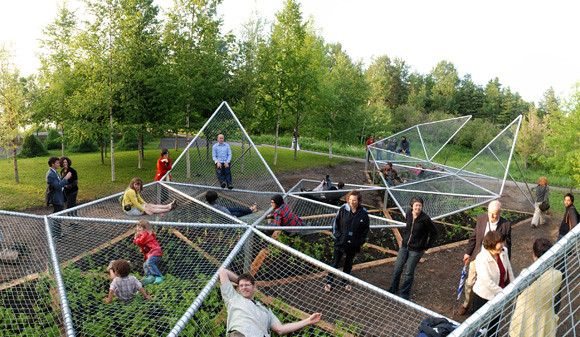Concrete Geometries – The Relational in Architecture
At the AA School in London a new exhibition is opening on the 7 Mai, with a focus on ‘Spatial Form in Social and Aesthetic Processes’. The exhibition follows an earlier symposium held in OCtober 2010 also at the AA School, with a very extensive list of speakers and topics like Social Contracts, Relational Space, Sensory Engagement and Perception and Cognition. These events are organised by Concrete Geometries, an ongoing interdisciplinary AA research initiative, investigating the social and experiential value of architectural form – its relational potential.
Concrete (adjective): capable of being perceived by the senses; not abstract or imaginary
Geometry (noun): a part of mathematics concerned with questions of size, shape, relative position of figures and with properties of space

Image taken from Kallaway / Dymaxion Sleep – Jane Hutton and Adrian Blackwell, Canada
An installation in the public realm. A structure of nets suspended over a field of aromatic plants
Credit: © Jane Hutton and Adrian Blackwell.
As Marianne Mueller, one of the directors of ‘Concrete Geometries’ and Diploma Unit Master at the AA School, explains: “‘Concrete Geometries’ is investigating the intimate relationship between spatial form and human processes – be they social or aesthetic – and the variety of new material entities this relationship might provoke. By bringing together art, architecture, sciences and humanities, the cluster aims to provide a platform beyond disciplinary boundaries.”
Some of these topics have been brushed on for example in the book ‘Installations by Architects‘ by Princeton Architectural Press. And this exhibition in a very engaging way continues this line of practice of very concrete and to a great extend practical investigation method.
“A corridor, so narrow that strangers brush shoulders; a platform through a densely inhabited house, changing the relationship between inhabitant and visitor; a room reshaped through a graphic pattern; a space under a motorway, sloped in a way that it is rendered useless for those who need it most.”

Image taken from Compute Schottland / Voussoir Cloud – Iwamoto Scott Architecture, USA. A site-specific installation consisting of a system of vaults, exploring the structural pardigm of pure compression coupled with an ultra-light material system. Credit: © Iwamoto Scott Architecture
With works by BAR Architekten, Barkow Leibinger, Adrian Blackwell + Jane Hutton, Brandlhuber + ERA Emde Schneider, Fran Cottell, Anthony Coleman, Easton+Combs, Lukas Einsele, Bettina Gerhold, Jaime Gili, Susanne Hofmann/Baupiloten, IwamotoScott, Graziela Kunsch & Rafi Segal, Christine Rusche, Kai Schiemenz, SMAQ, SPAN Architecture & Design, Atelier Tekuto, Studio Elmo Vermijs and Vincent Wittenberg. Words by Matthias Ballestrem, Kathrin Böhm/public works, Isabelle Doucet and Toni Kotnik,
The exhibition has been supported by CCW Graduate School, the Embassy of the Netherlands and the Austrian Cultural Forum in London.
Marianne Mueller explains: “The aim of Concrete Geometries, part of the AA School Research Cluster Programmes, is to transform how architects think about the creation of space and how it is used for everyday life. This topic seems quite an obvious thing to be exploring, but it is not a discussion that is being held in architecture today. By involving designers and artists we are able to rethink our practice on the creation of space. Digital design has provided architects with new tools to experiment with the use of space. We need to challenges our current thinking of space and how we as architects create it.”
Exhibition on from 7th Mai to 28th Mai 2011, Mon–Fri 10am–7pm, Sat 10am–3pm

Image taken from Compute Schottland / Connecting Corridor – Elmo Vermijs Studio, Netherlands. An installation connecting two buildings, the chosen form of which causes people to unexpectedly run into one another, Credit: © Elmo Vermijs Studio
